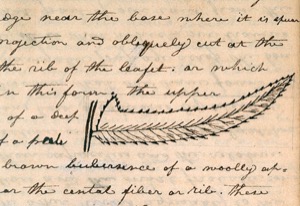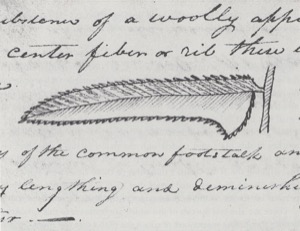February 13, 1806
[Lewis]
The Clatsop left us this morning at 11 A. M. not any thing transpired during the day worthy of notice. yesterday we completed the operation of drying the meat, and think we have a sufficient stock to last us this month. the Indians inform us that we shall have great abundance of a small fish in March which from their discription must be the herring. these people have also informed us that one More [1] who sometimes touches at this place and trades with the natives of this coast, had on board of his vessel three Cows, and that when he left them he continued his course along the N. W. coast. I think this strong circumstancial proof that there is a stettlement of white persons at Nootka sound or some point to the N. W. of us on the coast. [2]
There is a species of bryer which is common in this neighbourhood of a green colour which grows most abundant in the rich dry lands near the watercourses, but is also found in small quantities in the piny lands at a distance from the watercourses in the former situation the stem is frequently the size of a man's finger and rises perpendicularly to the hight of 4 or 5 feet when it decends in an arch and becomes procumbent or rests on some neighbouring plants or shrubs; it is simple unbranched and celindric; in the latter situation it is much smaller and usually procumbent. the stem is armed with sharp and hooked bryers. the leaf is peteolate ternate and resembles in shape and appearance that of the perple raspberry common to the Atlantic states. the fruit is a berry resembling the black berry in every rispect and is eaten when ripe and much esteemed by the natives but is not dryed for winter consumption. in the country about the entrance of the quicksand river I first discovered this bryer. it groows so abundantly in the fertile valley of Columbia and the Islands in that part of the river that the countrey near the river is almost impenitrable in many places. the briary bush with a wide leaf is also one of it's ascociates. the green bryer retains it's foliage and verdure untill late in December.— There are also two species of firn which are common to this country beside that formerly discribed of which the natives eat the roots. these from their disparity in point of size I shall designate the large and small firn. both species continue green all winter.— The large firn, [3] rises to the [height] of 3 or four feet the stem is a common footstalk or rib which proceedes immediately from the radix wich is somewhat flat on two sides about the size of a man's arm and covered with innumerable black coarce capillary radicles which issue from every pat of it's surface; one of those roots or a collected bed of them will send fourth from twenty to forty of those common footstalks all of which decline or bend outwards from the common center. these ribs are cylindric and marked longitudinally their whole length with a groove or channel on their upper side. on either side of this grove a little below it's edge, the leafets are inserted, being shortly petiolate for about ⅔ds of the length of the middle rib commencing at the bottom and from thence to the extremity sessile. the rib is terminated by a single undivided lanceolate gagged [jagged] leafet. the leafets are lanceolate, from 2 to 4 inches in length gagged and have a small accute angular projection on the upper edge near the base where it is spuar [square] on the side which has the projection and obliquely cut at the base on the other side of the rib of the leafet. or which will give a better idea in this form. [4] the upper surface is Smooth and of a deep green the under disk of a pale green and covered with a brown bubersence of a woolly appearance particularly near the central fiber or rib. these leafets are alternately pinnate. they are in number from 110 to 140; shortest at the two extremities of the common footstalk and longest in the center, graduly lengthening and deminishing as they succeed each other.—
February 13, 1806, Codex J, p. 71
The small firn [5] also rises with a comon footstalk from the radix and are from four to eight in number. about 8 inches long; the central rib marked with a slight longitudinal groove througout it's whole length. the leafets are oppositely pinnate about ⅓rd of the length of the common footstalk from the bottom and thence alternately pinnate; the footstalk terminating in a simple undivided nearly entire lanceolate leafet. the leafets are oblong, obtuse, convex absolutely entire, marked on the upper disk with a slight longitudinal groove in place of the central rib, smooth and of a deep green. near the upper extremity these leafets are decursively pinnate as are also those of the large firn. The grasses of this neighbourhood are generally coase harsh and sedge-like, and grow in large tufts. [6] there is none except in the open grounds. near the coast on the tops of some of the untimbered hills there is a finer and softer species which resembles much the green swoard. [7] the salt marshes also produce a coarse grass, [8] Bull rushes [9] and the Cattail flagg. [10] the two last the natives make great use in preparing their mats bags &c.—
[Clark]
The Clatsop left us this morning at 11 A. M. not anything transpired dureing the day worthy of notice. yesterday we completed the opperation of drying the meat, and think we have a Sufficient Stock to last us this month. the Indians inform us that we shall have great abundance of Small fish in March. which from the discription must be the Herring. Those people have also informed us that one Moore who sometimes touches at this place and traded with the nativs of this Coast, had on board his Ship 3 Cows, and that when he left them he continued his course along the N W. Coast. I think this (if those Cows were not Coats [goats]) Strong circumstantial proof that their is a Settlement of white persons at Nootka Sound or Some place to the N W. of us on the coast.
There are also two Species of firn which are common to this Countrey besides that before mentioned of which the nativs eate the roots. these two from their disparity in point of Size I shall distinguish the large and Small firn. both species continue green all winter—.
The large fern, rise to the hight of 3 or 4 feet, the Stem is a Common footstalk or rib which proceeds imediately from the radix which is Somewhat flat on two Sides about the Size of a man's arm and covered with innumerable black coarse capillary radicles which issue from every part of its surface; one of those roots or a collected bead of them will Send forth from 20 to 40 of those Common footstalks all of which decline or bend outwards from the Common center. those ribs are cylindric and marked longitudinally their whole length with a groove or channel on their upper Side. on either Side of this groove a little below it's edge, the leafets are inserted, being partly petiolate for about ⅔ds of the length of the middle rib, commenceing at the bottom and from thence to the extremity Sessile. the rib is termonated by a Single undevided lanceolate gagged leafet. the leafets are lanceolate, from 2 to 4 inches in length gagged and have a Small accute angular projection and obliquely cut at the base on either Side of the rib of the leafet. 〈on〉 upper Surface is Smooth and of a deep Green, the under disk of a pale Green and covered with a brown Substance of a woolly appearance particalarly near the center fiber or rib these leafets are alternately pointed [11] they are in number from 110 to 140; shortest at the two extremities of the common footstalk and longest in the center, gradually lengthing and diminishing as they Suckceed each other.—.
February 13, 1806, Voorhis No. 2
The Small firn also rises with a Common footstalk from the radix and are from 4 to 8 in number, about 8 inches long; the Central rib marked with a Slight longitudinal Groove through out it's whole length. the leafets are oppositly pinnate about ⅓ of the length of the Common footstalk from the bottom and thence alternately pinnate; the footstalk termonating in a Simple undevided nearly entire lanceolate leafet. the leafets are oblong, obtuse, convex absolutely entire, marked on the upper disk with a Slight longitudinal grove in place of the central rib, smooth and of a deep green; near the upper extremity those lefets are decurscivily pinnate as are also those of the larg firn.
The Grass's of this neighbourhood are generally coarse harsh and Sedge like, and grow in large tufts. there is none except in the open grounds. near the Coast on the top of Some of the untimbered hills there is a finer and Softer Species which resembles much the Greensword. the Salt marshes also produce a Corse grass, Bullrushes and the Cattail flaggs. of the two last the nativs make great use in prepareing their mats bags &c. in those bags they Carry their fish Berries roots &c.
[Ordway]
Thursday 13th Feby. 1806. cloudy and rain. one of the men bought a Sea otter Skin from the Indian for a peace of Tobacco not the half of a carrit. [12]
[Whitehouse]
Thursday Febry 13th It rained the greater part of last night, and this morning was Cloudy. the Men at the fort were employed making of Moccasins & mending their Cloathing &ca.




